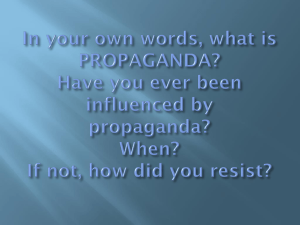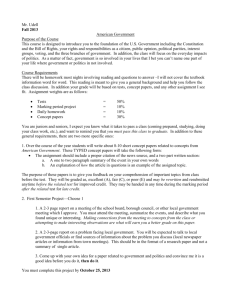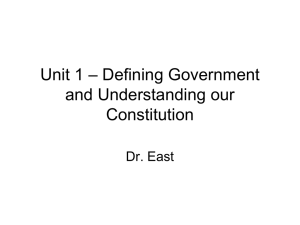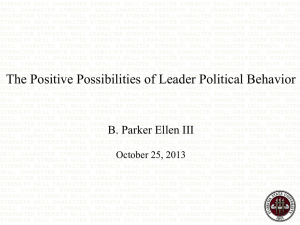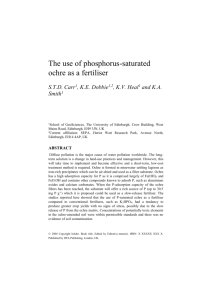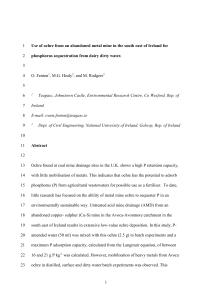Text A - Oxbridge Advanced Studies Program
advertisement
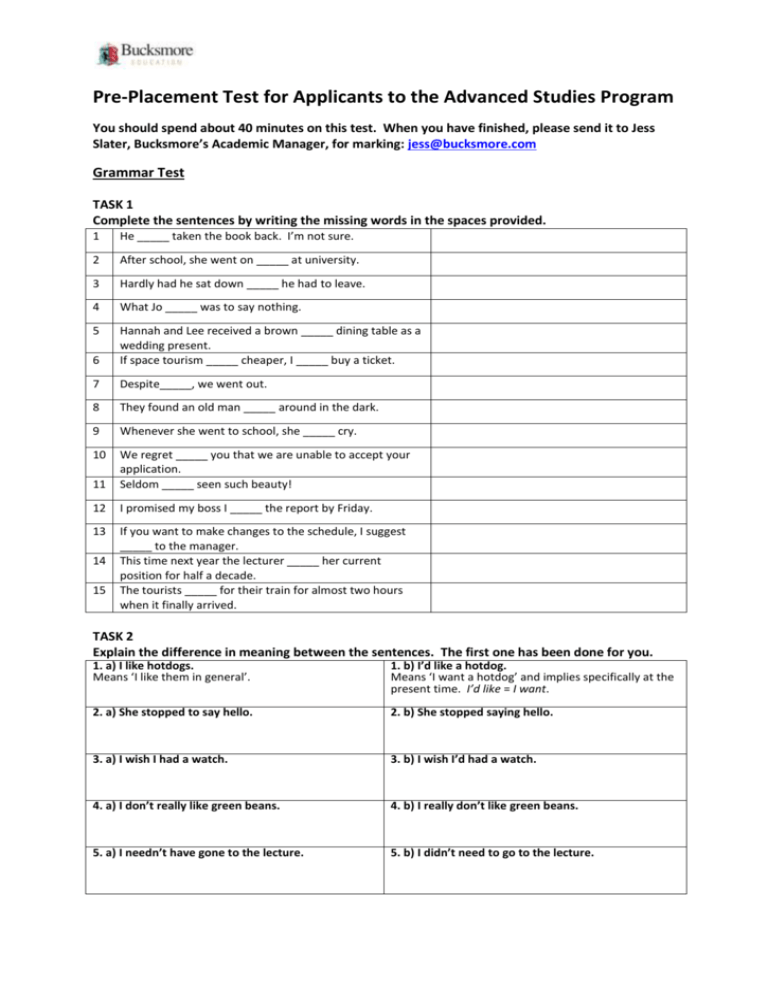
Pre-Placement Test for Applicants to the Advanced Studies Program You should spend about 40 minutes on this test. When you have finished, please send it to Jess Slater, Bucksmore’s Academic Manager, for marking: jess@bucksmore.com Grammar Test TASK 1 Complete the sentences by writing the missing words in the spaces provided. 1 He _____ taken the book back. I’m not sure. 2 After school, she went on _____ at university. 3 Hardly had he sat down _____ he had to leave. 4 What Jo _____ was to say nothing. 5 6 Hannah and Lee received a brown _____ dining table as a wedding present. If space tourism _____ cheaper, I _____ buy a ticket. 7 Despite_____, we went out. 8 They found an old man _____ around in the dark. 9 Whenever she went to school, she _____ cry. 10 11 We regret _____ you that we are unable to accept your application. Seldom _____ seen such beauty! 12 I promised my boss I _____ the report by Friday. 13 If you want to make changes to the schedule, I suggest _____ to the manager. This time next year the lecturer _____ her current position for half a decade. The tourists _____ for their train for almost two hours when it finally arrived. 14 15 TASK 2 Explain the difference in meaning between the sentences. The first one has been done for you. 1. a) I like hotdogs. Means ‘I like them in general’. 1. b) I’d like a hotdog. Means ‘I want a hotdog’ and implies specifically at the present time. I’d like = I want. 2. a) She stopped to say hello. 2. b) She stopped saying hello. 3. a) I wish I had a watch. 3. b) I wish I’d had a watch. 4. a) I don’t really like green beans. 4. b) I really don’t like green beans. 5. a) I needn’t have gone to the lecture. 5. b) I didn’t need to go to the lecture. Reading Test – Multiple Choice Read the four paragraphs overleaf and choose one of the possible answers to finish the sentences. Use the content of the reading text to choose your answer. Text A: The state-centric conception of world politics a) b) c) d) has been in place since the Middle Ages makes globalisation easier to take seriously causes world maps to give primacy to borders is a shift in the way we think about international relations Text B: In the market for bottled water in Eastern Europe a) b) c) d) Coca-Cola has a solid foothold local companies make all of the profit Coca-Cola is introducing coffee and tea products growth has been flat Text C: Neanderthal man created implements a) b) c) d) solely for use in the immediate physical world which are the earliest known objects to be called works of art made out of red ochre such as weapons and funeral monuments Text D: Myth was created a) b) c) d) by the early philosophers to be a cultural phenomenon to help people feel better about the transitory nature of life to contribute to the terror of existence Text A Consider a political map of the world: its most striking feature is the division of the entire earth’s surface into over 190 neatly defined territorial units, namely states. To a student of politics in the Middle Ages such a representation of the world, which gave primacy to borders and boundaries, would make little sense. Historically, borders are a relatively recent invention, as is the idea that states are sovereign, self-governing, territorially delimited political communities or polities. Although today a convenient fiction, this presumption remains central to orthodox state-centric conceptions of world politics as the pursuit of power and interests between sovereign states. Globalization, however, calls this state-centric conception of world politics into question. Taking globalisation seriously therefore requires a conceptual shift in the way we think about world politics. Source: Baylis et al., The Globalization of World Politics: An Introduction to International Relations, (OUP, 2010). Text B Recent developments shed some doubt on whether the company will be as successful as it is forecasting. Worldwide market growth has been flat and there has been a move away from carbonated drinks. In Eastern Europe, it is the market for bottled water that is booming. Between 1998 and 2004, per capita consumption of bottled water in Eastern Europe doubled. Although Coca-Cola Water Division is one of four major players, it is not the market leader and smaller, local competitors account for a large portion of the market. Other efforts to develop innovative, non-carbonated products have not proven very successful. The company knows that its future growth is going to depend heavily on its ability to supplement its current product line with new offerings such as vitamin-enriched drinks, and perhaps coffee and tea offerings. Worst of all, perhaps, a few years ago the company began centralising control and encouraging consolidation among its bottling partners. Coke believed that by making all key operating decisions in Atlanta, it could drive up profitability. Unfortunately, at the same time that it was pushing for this centralised type of operation, regional markets began demanding that the company be more responsive to local needs. In short, Coke was going global while the market wanted it to go local. Source: Rugman & Collinson, International Business, (Pearson, 2012). Text C Neanderthal man – homo sapiens neanderthalensis – who was living in Europe and west Asia from about 125,000 years ago, made a great variety of implements. Members of the sub-species coloured their bodies with red ochre. Their thoughts seem to have extended beyond the immediate physical world, for they buried the dead in graves with funeral gifts of food and weapons and, in at least one instance (at La Ferrassie in France), a kind of monument – a large stone from which pairs of concave cup-like marks had been pecked out. It is impossible to be certain about this, of course, but if the markings on the stone had a commemorative, magic or at any rate non-utilitarian purpose, the second step towards the making of art had been taken. These were the millennia of the last Ice Age, broken by slightly warmer ‘interglacial’ periods, during the last of which, around 40,000 BC, Neanderthal man vanished and another sub-species, the only one to survive and that to which we belong, made its appearance in Africa, Asia and Europe: Homo sapiens sapiens, as we are zoologically designated. In every essential respect, including brain capacity, these people were like ourselves. Before the final stage of the Ice Age, they had carved the earliest known objects that can be called works of art. Source: Honour & Fleming, A World History of Art, (Laurence King, 2009). Text D Important distinctions may be drawn between stories that are perceived as true and those that are not. The contrast between myth and reality has been a major philosophical concern since the time of the early philosophers. Myth is a multi-faceted personal and cultural phenomenon created to provide a reality and unity to what is transitory and fragmented in the world that we experience – the philosophical vision of the afterlife in Plato and any religious conception of a god are mythic, not scientific, concepts. Myth provides us with absolutes in the place of ephemeral values and with a comforting perception of the world that is necessary to make the insecurity and terror of existence bearable. Source: Morford et al., Classical Mythology, (OUP, 2011).


